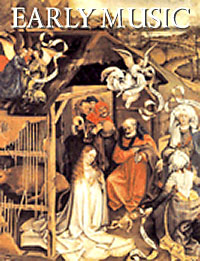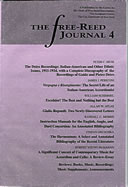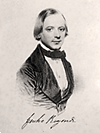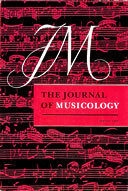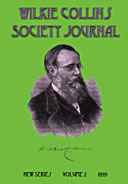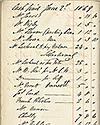In memory of Eric Van Tassel and Jan LaRue
Although the firm of Wheatstone & Co. was the
most prestigious manufacturer of the English concertina (see illus. 1) during the 19th
century,1
its editions of music for the instrument were often less than
satisfactory.
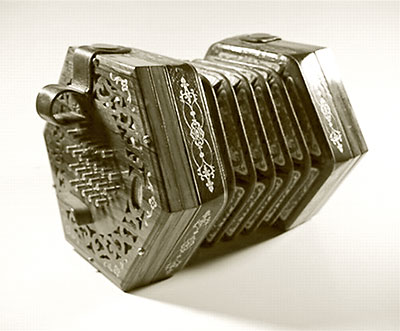 1. Wheatstone treble, No. 5899, with rosewood ends and its
1. Wheatstone treble, No. 5899, with rosewood ends and its
original brass reeds and meantone temperament still in place
(author’s collection).
The Wheatstone
sales ledger C1049, p. 92
(Wayne Archive, The Horniman Museum, London), shows that it was sold
for the first time on 5 March 1856 to Mr W. Peel, Esq., for
£12.12.0 (and was thus top-of-the-line); there is circumstantial
evidence that points to this being William Peel, third son of the late
Prime Minister, Sir Robert Peel (see my forthcoming article, ‘The
Gendered Concertina’, cited in n. 12); the extant nineteenth-century
Wheatstone sales ledgers appear online at
www.horniman.info.
One publication in particular, that of Giulio Regondi’s Serenade
pour la concertina avec accompagniment de piano forte, published in 1859 (though the piece
was likely composed some years earlier),2
may serve to illustrate the problems (see illus. 2 and illus. 3).
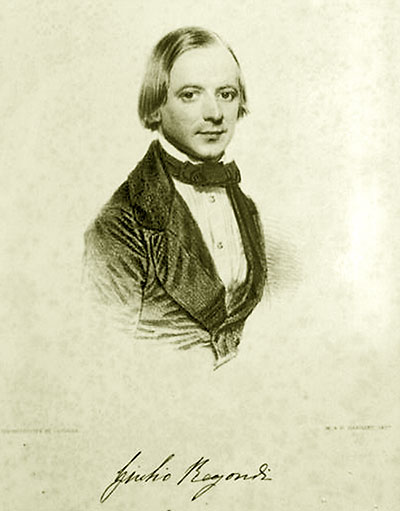 2. Giulio Regondi (1822–1872): lithograph by Edward Gunstone (1852),
2. Giulio Regondi (1822–1872): lithograph by Edward Gunstone (1852),
from a daguerreotype by Laroche (courtesy of Douglas Rogers).
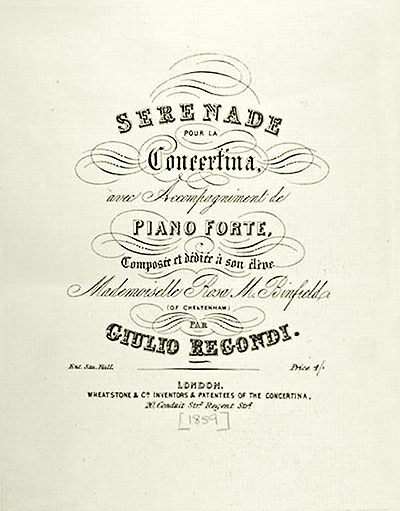 3. Title page of Serenade (Wheatstone & Co., [1859]).
3. Title page of Serenade (Wheatstone & Co., [1859]).
Rosa Binfield, to whom the piece was dedicated, was a member of the
Binfield family of Reading, a number of whom played and taught the
English concertina; Regondi was especially close with the family from
no later than 1839, when, probably at the Binfields' invitation, he
appeared at the Berkshire 11th Triennial Music Festival at Reading.
First, Wheatstone’s issued the Serenade in a format that consisted of separate piano
and concertina parts only (a practice in which they were certainly not alone),
thus requiring those who would have studied the piece closely to go
through the laborious task of scoring it up themselves. Indeed, we can only wonder how many
Victorian pianists accompanied “blindly,” as it were—that is, without the concertina part in front
of them—and with what results (though, to be sure, the interplay between the concertina and piano
is not complicated).
Second, recurring passages often show seemingly ‘irrational’—and
surely non-authorial—inconsistencies with respect to such matters as phrasing, articulation,
and embellishments. Example 1 illustrates those that permeate just one of the Serenade’s
recurring phrases.
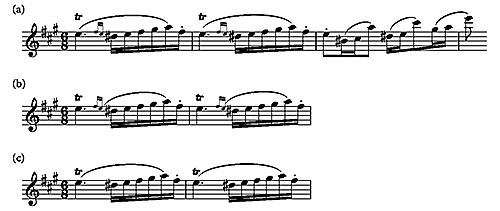 Ex. 1. Regondi, Serenade: a recurring phrase in the
Ex. 1. Regondi, Serenade: a recurring phrase in the
concertina part, with three different sets of indications for phrasing,
articulation, and embellishments: (a) bars 55-58, (b) bars 63-66,
and (c) bars 105-108 (repeated at bars 113-116).
Finally, though the publication contains no notes that are blatantly incorrect, there is one note
that is at least highly suspect, and it is on that note—surely the most interesting wrong or
questionable note in the entire repertory of Victorian art music
for the English concertina3
(and, in terms of the emendation that I will suggest, one of the most interesting regardless of period
or instrument in general)—that I will concentrate here.
The note in question—a high e’’’ (marked with an asterisk in Example 2a)—appears as
the final semiquaver in bar 159, where it stands as the penultimate note in a sweeping,
two-octave ascent of uninterrupted semiquavers that reaches its climax on the downbeat of
bar 160, on yet another e’’’. Example 2a provides the entire passage as it appears in the
Wheatstone publication, together with the
bar that immediately follows it.
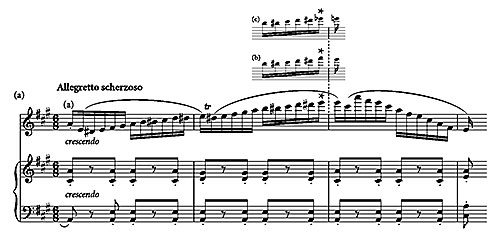 Ex. 2. Serenade, bars 158-161:
(a) reading in
Ex. 2. Serenade, bars 158-161:
(a) reading in
Wheatstone publication;
(b) suspect note emended to
read f’’’ sharp;
(c) suspect note emended to read e’’’ flat.
The problem as I see it is this: would Regondi have undercut and thereby deadened the
climactic e’’’ on the downbeat of bar 160 by anticipating it with the very same note just
one semiquaver earlier? Though the Dutch concertinist Wim Wakker and I each permitted the questionable e’’’ to
stand in our respective editions of the piece (see note 2), Regondi, I think, was too good a
composer to have ended the phrase as if hitting a wall—it is almost as if he miscalculated the
number of notes needed to make a clean sweep to the downbeat of bar 160—and I would
now suggest that the e’’’ at the end of bar 159 stands in need of emendation.
How, though, should we emend it? One possibility—already suggested (though in the
form of a question) in the critical notes to my edition—would be to emend the e’’’ with a note a
whole step higher, that is, with an f’’’ sharp, so that we approach the climactic e’’’ from above
(see Example 2b, where the emendation is marked with an asterisk).
This emendation has three things to recommend it: (1) the f’’’ sharp makes perfectly good
musical-grammatical sense, as we hear it as a fleeting added ninth above the dominant-seventh
chord that itself sounds over a tonic pedal (or, in terms of melodic function, an ‘incomplete’
upper-neighbour;4
(2) Regondi used that figure (a falling second
after an upward leap) throughout the Serenade, even if in different
contexts (see Ex. 3); and (3) it falls nicely under the concertinist’s fingers, more so, perhaps, than
the successive e’’’s.
 Ex. 3. Regondi, Serenade, recurring instances of the falling
Ex. 3. Regondi, Serenade, recurring instances of the falling
second on various scale steps including 6 – 5: (a) bars 59-60; (b) bars 67-68.
Finally, we can easily imagine a printer’s fair (or not-so-fair) copy in which the placement of the
f’’’ sharp at the end of measure 159 was just a bit off the mark. Perhaps the note head intersected (if even slightly)
with the ledger line instead of resting entirely upon it, and thus led the printer to take it
for and print it as an e’’.
Yet plausible as this emendation might be—both musically and in terms of accounting
for the printer’s likely error—5
I think Regondi might have had something else in mind. More
specifically, I think that we might be dealing with a typographical error of omission rather than
one of commission; and more specifically still, I think that a clue to a more likely emendation
lies in the prevailing temperament to which concertina manufacturers tuned their instruments at
the time.
Briefly, from the time that Charles Wheatstone developed the English concertina in the
late 1820s to some hazy and uncertain point in the mid-1850s/early 1860s, Wheatstone’s and other manufacturers
utilized a meantone temperament in which they divided the
octave into fourteen notes and, split key-like fashion, distinguished between the pitches of—and
provided separate buttons for—G sharp and A flat, on the one hand, and D sharp and E flat, on
the other, with the latter note of each pair
sounding forty-one cents—or approximately a quarter tone—higher than the former (see
illus. 4).6
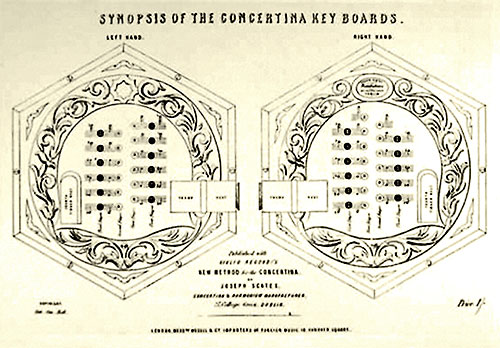 4. The button board of a 48-button, treble English concertina,
4. The button board of a 48-button, treble English concertina,
after Giulio Regondi, New Method for the Concertina
(Dublin: Joseph Scates, 1857).
Note that all notes written on the lines (or
ledger lines) of the staff appear in the left hand, while those in the
spaces appear in the right hand. The two inner vertical rows in each hand
give the white notes of the keyboard, the outer rows, the black notes.
Thus the g’ sharp is the next-to-lowest button in the innermost row
of the left hand, while the a’ flat is the third button from the bottom
in the innermost row of the right hand; the buttons directly above those give
d’’ sharp and e’’ flat respectively. Among the pairs of notes
in the D sharp/E flat and G sharp/A flat complexes, only the high g’’’ sharp
(highest button in the outermost row in the left hand) does not have a
complementary a’’’ flat.
That the manufacturers of what was in effect a new instrument opted to outfit it with a
seemingly outmoded temperament should not surprise us. First, England was relatively slow to adopt
equal temperament; and it was not until 1846, for example, that
the London firm of Broadwood adopted equal temperament as the standard tuning for its
pianos, while churchgoers could still hear the occasional meantone organ for another forty or so
years after that.7
Second, Charles Wheatstone was a physicist, not, as far as we know, a
practical musician, and his main interests in music lay primarily in the field of acoustics. In fact,
his “Harmonic Diagram” of 1824 (see illus. 5) and the published “Explanation” that accompanied it betray a
mind intent on dividing the whole tone into a number of microtonal
parts.8
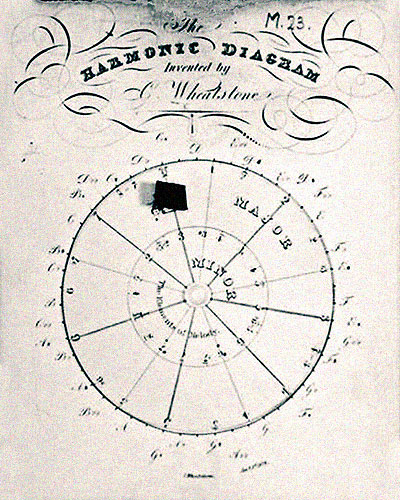 5. Charles Wheatstone’s ‘Harmonic Diagram’ (1824)
5. Charles Wheatstone’s ‘Harmonic Diagram’ (1824)
(British Library, Music Division, M.23).
What, then, does all of this have to do with our problematic e’’’? I would suggest that
we might emend that note simply by inserting a flat in front of it, thus exploiting the D sharp/E flat
dichotomy and altering the passage to read as shown in Example 2c (the emendation marked by an asterisk).
The benefits of this emendation are at least fourfold: (1) it keeps the ascending scale passage
intact right up to the very end (unlike either the e’’’ natural or the f’’’ sharp); (2) it
produces the ‘tightest’ possible leading tone to the climactic e’’’ on the downbeat of bar
160; (3) if the fair copy had the flat in front of the e’’’,
it charges Wheatstone’s printer with less egregious error—one of omission—than does the emendation
that calls for the f’’’ sharp (in fact, we might even excuse it on the
grounds that the printer's eyes may have rolled upon seeing d’’’ sharp and e’’’ flat in succession;
and (4) it too lies nicely under the fingers.
Finally, among composers who wrote for the English concertina Regondi was not
alone in exploiting the forty-one-cent difference in pitch between the D sharp/E flat or the
G sharp/A flat that the meantone temperament and fourteen-note octave made possible. And
though I cannot claim to have seen every last one of the hundreds of pieces written for the
English concertina during its “meantone period”, I can point to at least two other
instances in which composers wrote for the instrument with an ear toward that temperament.
The later of these appears in George Alexander Macfarren’s Barcarole, which, like Regondi’s
Serenade, was published in 1859 (but, unlike it, was probably composed either that
same year or only shortly before then). In fact, as Example 4 shows, Macfarren was rather more
daring than Regondi, as he has the concertina lean heavily on an a’ flat that serves as a high-and-tight (and
somewhat dissonant) leading tone to an a natural while the piano (by now presumably in equal
temperament) arpeggiates a G-sharp-filled C-augmented chord (and the G sharp could
not have been in tune with the concertina's A flat) that will resolve to a triad on
F.9
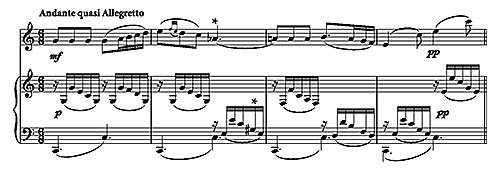 Ex. 4. Macfarren, Barcarole, bars 3-6 (repeated
Ex. 4. Macfarren, Barcarole, bars 3-6 (repeated
at bars 65-68).
The earlier instance occurs in Joseph
Warren’s Grand Fantasia in which is Introduced “Deh! Con te,” from Bellini’s Opera Norma,
which, though not published until 1855, was one of the two pieces with which the fifteen-year-old Regondi put the
fledgling English concertina on the map as a concert instrument when he performed it at the
Birmingham Festival in 1837.10
And here even the context is similar, as the movement from
d’’’ sharp to e’’’ flat makes the chromatic scale even more “colourful” than equal temperament
would allow (see Example 5).
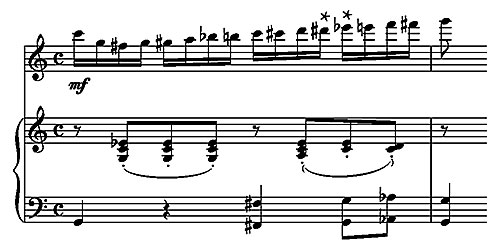 Ex. 5. Warren, Grand Fantasia, bars 148-149 (asterisks
Ex. 5. Warren, Grand Fantasia, bars 148-149 (asterisks
mark the d’’’ sharp and e’’’ flat).
In all, I would not be surprised if Regondi had Warren’s piece in his ear when he
chose to exploit the forty-one-cent difference between D sharp and E flat.
In conclusion, I rather expect my proposed emendation to be greeted with yawns. After
all: (1) the English concertina was, in terms of its role in art-music circles, a marginal instrument even during its mid-nineteenth-
century heyday, when it was a familiar sight and sound in London’s leading concert halls and a
most fashionable instrument among the upper- and upper-middle classes as a whole, the titled
aristocracy very much included;11
(2) Regondi is not a giant among composers (though his
contributions to the repertories of both the English concertina and the guitar are seminal); and
(3) the focus of Wheatstone & Co’s publishing activity was extremely narrow. And yet, there is
something rather special about this little forty-one-cent emendation. For as far as I can tell, it
is the only instance—regardless of period or instrument—in which what is likely the correct
emendation of a wrong (or at least suspect) note is driven entirely by the temperament/tuning
of the instrument for which it was written.
Author
Allan Atlas (
)
is Distinguished Professor of Music at The Graduate Center, The City University of New York,
where he is director of The Center for the Study of Free-Reed Instruments. He plays the English
concertina (he is a member of the New York Victorian Consort, with Julia Grella O’Connell,
mezzo-soprano, and Francesco Izzo, piano), and is currently working on a large-scale study titled
‘The Gendered Concertina in Victorian England: Ladies in the Wheatstone Sales Ledgers
(1834–1870)’.
